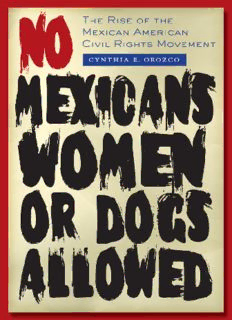
No Mexicans, Women, or Dogs Allowed: The Rise of the Mexican American Civil Rights Movement PDF
Preview No Mexicans, Women, or Dogs Allowed: The Rise of the Mexican American Civil Rights Movement
NO ME XIC A NS, WOMEN, OR DOG S A L LOW E D TT55110077..iinnddbb ii 99//11//0099 88::4411::2244 AAMM THIS PAGE INTENTIONALLY LEFT BLANK NO MEXICANS, WOMEN, OR DOGS ALLOWED The Rise of the Mexican American Civil Rights Movement CYNTHIA E. OROZCO UNIVERSITY OF TEXAS PRESS, AUSTIN TT55110077..iinnddbb iiiiii 99//11//0099 88::4411::2244 AAMM COPYRIGHT © 2009 BY THE UNIVERSIT Y OF TEX AS PRESS All rights reserved Printed in the United States of America First edition, 2009 Requests for permission to reproduce material from this work should be sent to: Permissions University of Texas Press P.O. Box 7819 Austin, TX 78713–7819 www.utexas.edu/utpress/about/bpermission.html The paper used in this book meets the minimum requirements of ANSI/NISO Z39.48-1992 (R1997) (Permanence of Paper). LIBR ARY OF CONGRESS C ATALOGING-IN-PUBLIC ATION DATA Orozco, Cynthia. No Mexicans, women, or dogs allowed : the rise of the Mexican American civil rights movement / Cynthia E. Orozco. — 1st ed. p. cm. Includes bibliographical references and index. ISBN 978–0–292–72109–8 (cloth : alk. paper) — ISBN 978–0–292–72132–6 (pbk. : alk. paper) 1. Mexican Americans—Civil rights—History—20th century. 2. League of United Latin American Citizens—History. 3. Order of Sons of America— History. 4. Civil rights movements—United States—History—20th century. 5. Mexican Americans—Civil rights—Texas—History—20th century. 6. Civil rights movements—Texas—History—20th century. 7. Mexican Americans—Texas—Social conditions— 20th century. 8. Mexican American women—Texas—Social conditions—20th century. I. Title. E184.M50775 2009 973′.0468720764—dc22 2009020110 TT55110077..iinnddbb iivv 99//11//0099 88::4411::2244 AAMM FOR MY PARENTS, AURORA AND PRIMITIVO, AND MY SON/DOG, BUDDY, AND IN MEMORY OF JOHN SOLÍS, M. C. GONZÁLES, ADELA SLOSS-VENTO, MARÍA L. HERNÁNDEZ, AND EMMA TENAYUCA. TT55110077..iinnddbb vv 99//11//0099 88::4411::2244 AAMM THIS PAGE INTENTIONALLY LEFT BLANK CONTENTS ACKNOWLEDGMENTS ix INTRODUCTION 1 PART ONE Society and Ideology 15 ONE The Mexican Colony of South Texas 17 TWO Ideological Origins of the Movement 40 PART TWO Politics 63 THREE Rise of a Movement 65 FOUR Founding Fathers 92 FIVE The Harlingen Convention of 1927: No Mexicans Allowed 120 0000--TT55110077--FFMM--RRVV11..iinndddd vviiii 99//88//0099 99::2200::3399 AAMM SIX LULAC’s Founding 151 PART THREE Theory and Methodology 181 SEVEN The Mexican American Civil Rights Movement 183 EIGHT No Women Allowed? 196 CONCLUSION 221 APPENDICES 231 NOTES 241 SELECTED BIBLIOGRAPHY 299 INDEX 309 TT55110077..iinnddbb vviiiiii 99//11//0099 88::4411::2255 AAMM ACKNOWLEDGMENTS This book is about the origins of the most important U.S. civil rights orga- nization for people of Mexican descent. Mexican American men founded the League of United Latin American Citizens (LULAC) in Corpus Christi, Texas, in 1929. I began this book in a Chicano history class with Professor Víctor Nelson Cisneros at the University of Texas at Austin in 1978. I grew up in Cuero, Texas, a town of European Americans, Mexican Americans, Mexicans, and African Americans. Cuero lies at the pinnacle of historical sites associated with Texas independence and anti-Mexican sentiment—Gonzales, Goliad, and San Antonio. Thirty miles from Gonza- les, we heard the refrain “Come and take it”; thirty miles from Goliad (La Bahía), we learned of the massacre; and seventy miles from San Antonio, we were instructed to “Remember the Alamo.” In the 1960s and 1970s de jure racial segregation and de facto segregation were in effect according to race—“white,” “Mexican,” and “black.” Slavery had thrived in Cuero, and a third of the population was African American in 1900. My neighborhood consisted of Mexican Americans, whites, and Afri- can Americans, including the son of a slave. When my Mexican immigrant parents moved from South Texas to Cuero in the 1950s they found extensive racial discrimination. In the 1920s my mother immigrated from Nuevo León, Mexico, to Mercedes, Texas, where a schoolteacher whipped her hands with a rubber hose because she spoke Spanish. She has self-identifi ed mostly as a Mexican American, while my father died with a Mexican identity, rejecting U.S. citizenship and refus- TT55110077..iinnddbb iixx 99//11//0099 88::4411::2255 AAMM
